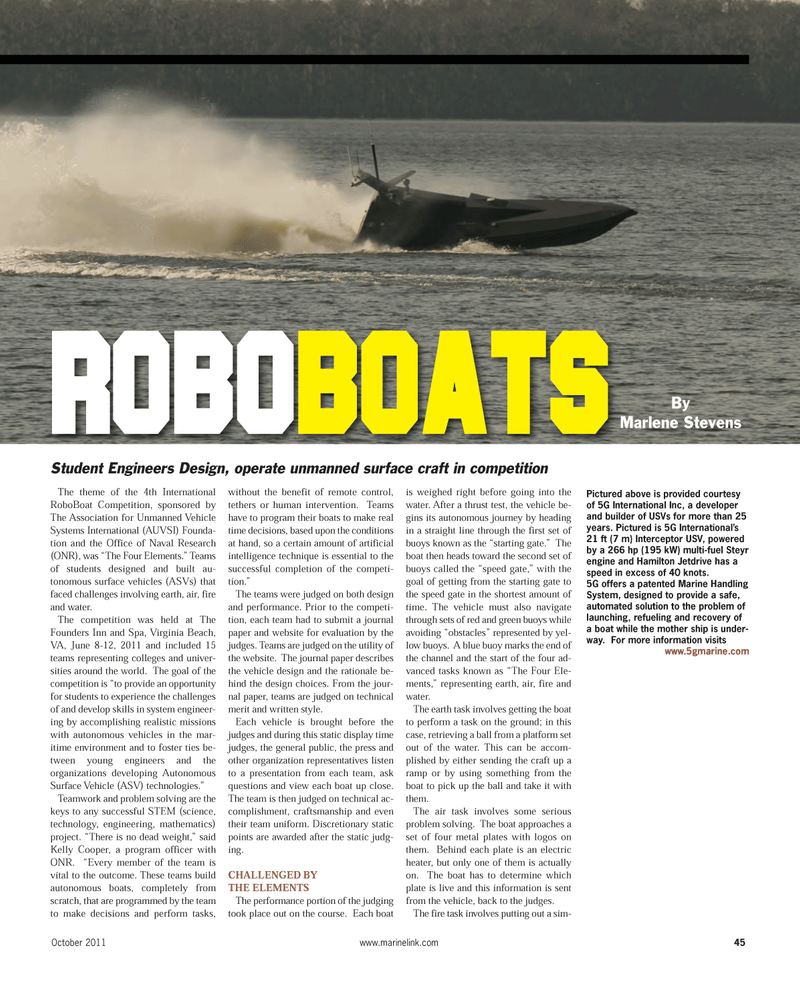
Page 45: of Maritime Reporter Magazine (October 2011)
Marine Design Annual
Read this page in Pdf, Flash or Html5 edition of October 2011 Maritime Reporter Magazine
The theme of the 4th InternationalRoboBoat Competition, sponsored byThe Association for Unmanned Vehicle Systems International (AUVSI) Founda- tion and the Office of Naval Research (ONR), was ?The Four Elements.? Teams of students designed and built au- tonomous surface vehicles (ASVs) that faced challenges involving earth, air, fire and water. The competition was held at The Founders Inn and Spa, Virginia Beach, VA, June 8-12, 2011 and included 15 teams representing colleges and univer- sities around the world. The goal of the competition is ?to provide an opportunity for students to experience the challenges of and develop skills in system engineer- ing by accomplishing realistic missionswith autonomous vehicles in the mar- itime environment and to foster ties be- tween young engineers and theorganizations developing Autonomous Surface Vehicle (ASV) technologies.? Teamwork and problem solving are the keys to any successful STEM (science, technology, engineering, mathematics) project. ?There is no dead weight,? said Kelly Cooper, a program officer with ONR. ?Every member of the team is vital to the outcome. These teams build autonomous boats, completely fromscratch, that are programmed by the teamto make decisions and perform tasks, without the benefit of remote control, tethers or human intervention. Teams have to program their boats to make real time decisions, based upon the conditionsat hand, so a certain amount of artificial intelligence technique is essential to thesuccessful completion of the competi-tion.? The teams were judged on both designand performance. Prior to the competi-tion, each team had to submit a journalpaper and website for evaluation by the judges. Teams are judged on the utility of the website. The journal paper describes the vehicle design and the rationale be- hind the design choices. From the jour- nal paper, teams are judged on technical merit and written style.Each vehicle is brought before the judges and during this static display timejudges, the general public, the press andother organization representatives listen to a presentation from each team, askquestions and view each boat up close. The team is then judged on technical ac-complishment, craftsmanship and even their team uniform. Discretionary staticpoints are awarded after the static judg- ing.CHALLENGED BY THE ELEMENTSThe performance portion of the judgingtook place out on the course. Each boatis weighed right before going into thewater. After a thrust test, the vehicle be- gins its autonomous journey by heading in a straight line through the first set of buoys known as the ?starting gate.? The boat then heads toward the second set of buoys called the ?speed gate,? with the goal of getting from the starting gate to the speed gate in the shortest amount of time. The vehicle must also navigate through sets of red and green buoys while avoiding ?obstacles? represented by yel- low buoys. A blue buoy marks the end of the channel and the start of the four ad-vanced tasks known as ?The Four Ele- ments,? representing earth, air, fire and water. The earth task involves getting the boat to perform a task on the ground; in thiscase, retrieving a ball from a platform set out of the water. This can be accom- plished by either sending the craft up aramp or by using something from theboat to pick up the ball and take it with them.The air task involves some serious problem solving. The boat approaches a set of four metal plates with logos onthem. Behind each plate is an electricheater, but only one of them is actually on. The boat has to determine which plate is live and this information is sent from the vehicle, back to the judges. The fire task involves putting out a sim- October 2011www.marinelink.com 45ROBOBOATSPictured above is provided courtesy of 5G International Inc, a developerand builder of USVs for more than 25 years. Pictured is 5G International?s 21 ft (7 m) Interceptor USV, powered by a 266 hp (195 kW) multi-fuel Steyrengine and Hamilton Jetdrive has aspeed in excess of 40 knots.5G offers a patented Marine Handling System, designed to provide a safe, automated solution to the problem of launching, refueling and recovery of a boat while the mother ship is under- way. For more information visits www.5gmarine.com Student Engineers Design, operate unmanned surface craft in competitionBy Marlene StevensMR Oct.11 # 6 (42-49):MR Template 10/5/2011 1:01 PM Page 45

 44
44

 46
46
